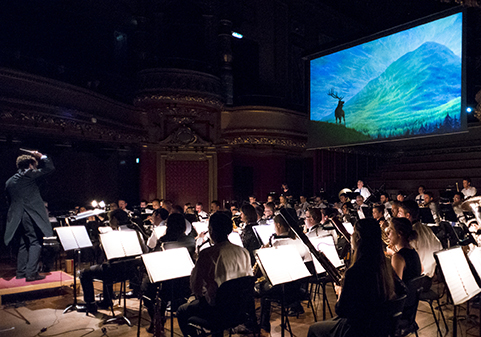Wednesday November 30th at 6:30 pm
Rolex Learning Center Forum
Music interpreted live by the Harmony Orchestra of Geneva State (OHGe)*
Today a cult film, however Fantasia was a bitter failure for Disney Movies studios when it came out
in theaters during the 1940s.
The film was showed on French screens after the end of World War Two, in November 1946.
While Walt Disney first wanted to create an ever evolving film with new scenes, this project was
quickly abandoned. It is only later that this film was recognised as Walt Disney’s most significant
masterpiece and it is in that spirit that Roy Edward Disney decided in 1999 to continue his uncle’s
work, deceased in the meantime, by creating a sequel to Fantasia: Fantasia 2000.
Just like its predecessor, this latter is also composed with 8 sequences, each illustrated with a
classical piece, in this order :
- Symphony no. 5 (Beethoven)
Abstract cartoon film
- Pines of Rome (Respighi)
Some whales swim between icebergs then fly over the oceans
- Rhapsody in Blue (Gerschwin)
Crossed destinies for a black worker passionate with jazz music, a starving and penniless unemployed person, a good man tyrannised by his wife, and a little girl coming from a good family with a heavy schedule
- Piano Concerto no. 2 (Shostakovitch)
The Steadfast Tin Soldier, from Anderson’s tale
- The Carnaval of the Animals (Saint-Saëns)
A flamingo plays with a yo-yo - The Sorcerer’s Apprentice (Dukas)
Unique and famous rerun of the 1940 Fantasia sequence and with a story inspired by Goethe’s ballad, Der Zauberlehrling
- Pomp and Circumstance (Elgar)
Noah’s Ark with the Deluge with… Donald and Daisy
- The Firebird (Stravinsky)
Hymn to life, death and revival
Often (and wrongfully in our opinion) considered as a dull copy of the first «1940 » Fantasia film,
Fantasia 2000 contains a few treasures, like this film inspired by new-yorker satirical cartoonist Al
Hirschfeld who takes back to the financial crisis of the 1920s in the United States or the last
sequence, this tale about the death and renewal of a forest, work of the two Brizzi Italian twins.
Musically, we can only admire the precision with which the partitions have been cut. It is hard to
see, as the linkings are so fast, that the Deluge sequence is a real potpourri of Elgar’s piece, and
the perfect adequation between film and music leaves us stunned (The Steadfast Tin Soldier and
Shostakovich’s music make of it a really good example.)
* Formed by about sixty amateur and professional musicians, the OHGe is a part of the Landwehr Music Body which is since 2005 the only official music of Geneva State
